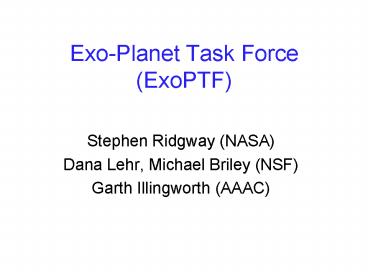ExoPlanet Task Force ExoPTF PowerPoint PPT Presentation
Title: ExoPlanet Task Force ExoPTF
1
Exo-Planet Task Force (ExoPTF)
- Stephen Ridgway (NASA)
- Dana Lehr, Michael Briley (NSF)
- Garth Illingworth (AAAC)
2
Publications and Planets
3
One year of ExoPlanet Conferences
- October 16 - 18 , 2006
- 6th workshop of the European Astrobiology Network
Association - Lyon, France
- October 23 - 27 , 2006
- From Brown Dwarfs to Planets
- Leiden, Neederland
- November 06 - 10 , 2006
- TPF/Darwin Workshop
- Pasadena, CA, USA
- December 04 - 08 , 2006
- Disks, Winds, and Jets From Planets to Quasars
- Mount Stromlo Observatory, Canberra, Australia
- December 27 , 2006 - January 05 , 2007
- The Lives of Low-Mass Stars and their Planetary
Systems - Jerusalem, Israel
- January 05 - 06 , 2007
- Evolution and Exploration of Solar Systems
- Irvine, CA, USA
- January 07 - 11 , 2007
- April 11 - 14 , 2007
- From Stars to Planets Connecting our
Understanding of Star and Planet Formation - Gainesville, FL, USA
- May 28 - June 08 , 2007
- Summer School Circumstellar Disks and Planets at
Very High Angular Resolution - Porto, Portugal
- June 09 - July 06 , 2007
- Summer School on Extrasolar Planets and Brown
Dwarfs - Castel Gandolfo, Rome, Italia
- June 22 - 24 , 2007
- Transformational Science with ALMA Through Disks
to Stars and Planets - Charlottesville, VA, USA
- June 24 - 29 , 2007
- Extreme Solar Systems
- Santorini, Hellas
- July 17 - 20 , 2007
- Bioastronomy 2007 Molecules, Microbes, and
Extraterrestrial Life - San Juan, Puerto Rico
- October 01 - 05 , 2007
4
IAU Colloquium 200
5
Active ExoPlanet/Exosystem Observational Programs
- Radial velocity monitoring
- Transit searches
- Microlensing
- YSOs, preplanetary and debris disks
6
Recent Results for ExoSystems
- Many detections
- Rich variety of exosystems
- Multi-planet systems
- Lower masses
- Closer to solar system analogues
- Potentially Earth-like planets may be common
7
Status of Major NASA ExoPlanet Missions
- Kepler - exoplanet study by transits
- Statistics of short-period planets - down to
Earth-size - In implementation
- SIM - exoplanet study by astrometry
astrophysics - Detection of nearby candidate Earth-like planets
- In formulation
- Advanced stage of engineering readiness
- Currently delayed - engineering/prototyping/scienc
e preparation continues - TPF - exoplanet study by spectroscopy
astrophysics - Direct study of candidate Earth-like planets
- In pre-formulation
- Key (enabling) technical demonstrations completed
in infrared interferometry and visible
coronagraphy - Currently deferred - technical/scientific
development continues
Navigator
8
Astronomy and Astrophysics Decade Review2007 -
2010
AAAC ExoPlanet Task Force2006 - 2007
9
The ExoPTF Charge (draft)
- This letter is to request that the AAAC establish
an Exo-Planet Task Force as a subcommittee to
jointly advise NSF and NASA on the future of the
search for and study of exo-planets, planetary
systems, Earth-like planets and habitable
environments around other stars.
10
The ExoPTF Charge (draft)
- The ExoPTF is asked to recommend a 15-year
strategy to detect and characterize exo-planets
and planetary systems, and their formation and
evolution, including specifically the
identification of nearby candidate Earth-like
planets and study of their habitability. The
strategy may include planning and preparation for
facilities and missions beyond the 15-year
horizon.
11
The ExoPTF Charge (draft)
- 1. The key scientific questions and issues, in
the context of recent developments in exo-planet
science and planet formation - 2. Measurement techniques, their enabling
technologies, and their implications for future
survey and measurement directions and priorities - 3. Specific types of experiments (e.g., radial
velocity measurements, transit searches,
microlensing, adaptive optics, coronagraphy) with
respect to their expected scientific return and
contributions - 4. The potential and complementary science return
from measurements at different wavelengths - 5. Major decision points in the exo-planet study
process - 6. Important steps, precursor instrumentation on
the ground or in space, RD, and other work
required in preparation for, in support of, or
alternative to, these and related experiments and
missions - 7. Identification of the nature and scope of
investments in key technologies relevant to the
scientific goals of the program - 8. The complementary ground-based and space-based
research opportunities, coordination between
funding agencies and possible synergistic
advances - 9. Opportunities for cooperation, coordination or
synergy with international programs, such as the
Darwin mission at the European Space Agency, or
the Ground-based European Nulling Interferometer
Experiment (GENIE) and Very Large Telescope
Interferometer (VLTI) projects at the European
Southern Observatory - 10. Cost effectiveness and affordability.
12
Notional Schedule
- Dec 2006 - First telecon, invite white papers,
form working groups - Jan 2007 - briefings and discussion
- Mar 2007 - briefings and discussion
- May 2007 - recommendations, report outline,
assignments - July 2007 - recommendations and writing
- Sept 2007 - review, wordsmithing, concurrence
- Oct 2007 - deliver report

